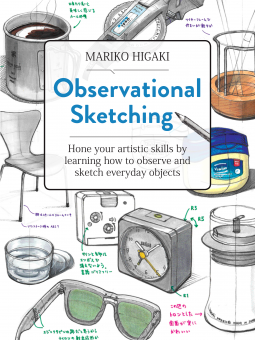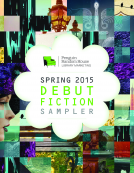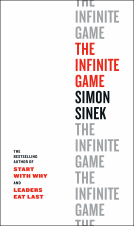
Observational Sketching
Hone Your Artistic Skills by Learning How to Observe and Sketch Everyday Objects
by Mariko Higaki
This title was previously available on NetGalley and is now archived.
Send NetGalley books directly to your Kindle or Kindle app
1
To read on a Kindle or Kindle app, please add kindle@netgalley.com as an approved email address to receive files in your Amazon account. Click here for step-by-step instructions.
2
Also find your Kindle email address within your Amazon account, and enter it here.
Pub Date Jan 07 2020 | Archive Date Jan 27 2020
Quarto Publishing Group – Rockport Publishing | Rockport Publishers
Talking about this book? Use #ObservationalSketching #NetGalley. More hashtag tips!
Description
Perspective, proportion, lines, shapes, shading, and many other techniques can be learned through everyday practice and observation of the items you come in contact with everyday, from a backpack to your sunglasses. This book addresses how to approach sketching a range of shapes and materials and how to disassemble each object to accurately capture its unique design elements. Inspiration and examples from the author and other well-known artists accompany a variety of projects that you can try right away and skill-building projects that will strengthen your talent. Find within:
- An introduction to observational sketching
- The basic concepts and tools used in observational sketching
- Observation techniques
- Illustrated step-by-step instructions for creating observational sketches of 20 common objects, from a alarm clock to a wooden stool
Available Editions
| EDITION | Other Format |
| ISBN | 9781631598883 |
| PRICE | $18.99 (USD) |
| PAGES | 128 |
Featured Reviews
 jc C, Educator
jc C, Educator
This book was not what I expected but I found it very interesting. It would be ideal for engineering, architecture and other subjects where technical drawing is important. It is still brilliant for artists too as it encourages you to slow down and look more carefully at objects, to really see them. To consider the material they are made of, their life span, and how they are put together. I was intrigued by the detail of the sketches. It is not really a book for beginners learning to draw, but it would definitely be useful for any level of artist learning to observe better.
 Media/Journalist 16509
Media/Journalist 16509
I can't give a star rating to this book as I seem to have been given an ARC that's quite unfinished. Entire pages are blank. Others have sketches and lines where I assume text will go. I am guessing that this needed to be translated and much of that is not done. THAT SAID, the illustrations seem to be finished and those are quite technical. This is clearly a book for advanced artists looking to hone their technique, not beginning sketchers. Higaki's finished sketches are impressive. Simple objects like a jar of Vaseline are perfectly drawn with great detail. He seems to go over the basics about things like perspective and he also apparently asks questions like to consider the materials of the object (without the text, all I can see is this command in bold and no discussion or instruction).
Very detailed examples are given of ordinary objects he has drawn with great detail (a LEGO minifigure, a leather couch, a beauty product, a pair of sunglasses, a label maker...). These almost look like architectural plans, and some sketches show things as if they were taken apart in order to understand how to draw them better. Again, without text it's hard to know context.
NetGalley and the publisher provided a temporary digital ARC for the purpose of review.
 Karen G, Reviewer
Karen G, Reviewer
I really enjoyed this observational sketching book. I liked the different styles of the different sketchers and the deep research about how each ordinary piece that they sketched is actually manufactured. The book has a simple but relatively comprehensive tutorial on how to sketch basic objects, focusing on perspective, shapes and breaking things down. It then proceeds to give examples of sketches done for each simple object from multiple perspectives.
It's not really an instructional book and it's not pure eye candy either. I'd say it sits somewhere in the middle. There is a lot of detail in each sketch, showing the smallest pieces of each item.
If you're interested in sketching, especially everyday ordinary objects, you will like this one.
with gratitude to netgalley and Quarto Publishing Group for an early copy in exchange for an honest review.
Observational Sketching: How to Draw Almost Any Object is a tutorial art & technique guide by Mariko Higaki. Originally released in Japanese in 2019, this English translation from Quarto on their Rockport imprint is due out 7th Jan 2020. It's 128 pages and will be available in paperback format.
The style is technical, almost isometric (see cover). The author includes a number of short essays from other technical artists and engineers on various aspects of observational sketching such as product design and packaging design. I found the design process very interesting and enlightening. These include a Q&A format on the artistic process, the artists development and careers, and other information about how to actually get what one sees onto the paper in a recognizable form.
The chapters are arranged thematically: What observational sketching is (and what's the appeal), basic tutorials and techniques which anyone can use right away, how to observe and render different surfaces (such as metals, plastics, etc), and the step by step specific tutorials.
I find the style very appealing (then again, I'm an engineer and pretty much anything I need to draw on a daily basis -needs- to be pared down and technical). I found a number of really good tips for rendering drawings which actually look like what I'm aiming for.
Lots of worthwhile tutorial information here.
Four stars.
 Natalie H, Reviewer
Natalie H, Reviewer
I received an advanced reader copy of this book in exchange for an honest review via netgalley and the publishers.
This book is fantastically detailed all the way through and gives fantastic step by step instructions as well as tips.
I loved how it introduced the artists and gave information about each of them at the beginning.
I cant wait to have a go at afew of these sketches.
 Oldřiška S, Reviewer
Oldřiška S, Reviewer
Not exactly what I expected, but interesting regardless. This book is more suited for people who do technical sketches - interior design, architecture etc., rather than for hobbyist. Though, I can see hobbyists finding this book helpful too.
The book goes into extremely detailed descriptions on how to sketch for example a watch. It discusses how to capture different materials, dimensions, how to authentically draw labels. I feel like the book itself radiates the essential thing needed for successful observational sketching - precision.
Even though for me, it was too technical, I can say that the book is very well put together and the right person will find it immensely helpful.
 debra m, Reviewer
debra m, Reviewer
Observational Sketching is an extremely detailed book on drawing. The author provides a very useful explanation of perspective with lots of examples. Then the book continues to elaborate sketches of everyday objects that are way beyond my level.
I think this book is perfect for the advanced artist. Step by step instructions is provided. However, I do not possess the skills to be able to follow them and have good results. After the explanation of perspective, I don’t think this book is a good fit for beginners.
I received this galley from NetGalley.
This book was not what I expected. However, it was very interesting to look at. I’m not sure I really learned much about actually drawing that was helpful but it does have a great deal of information concerning how to be more observant in looking closely at the details of an object. I believe it could be helpful in the aspect of seeing or having detailed observations on a given object that may prove useful for artist that already has well developed drawing skills. I’m not sure this would be helpful to someone trying to learn to draw. I received this book from NetGalley for an honest review.
 Agnes P, Reviewer
Agnes P, Reviewer
This is a very interesting book as it make the reader to look at ordinary everyday objects with a new eye, as ingegnieur and as artist, too. Taking them apart, analizing forms, material, the fabbrication process, Some has been formed through centuries, some are modern inventions, anyway they are formulated for the customer comodity. It is a refreshing look, to try out.
 Leyla J, Reviewer
Leyla J, Reviewer
If you want to improve your sketching and want a different outlook, this book will certainly focus your drawing and show another side of everyday items, adverts engineering and sharing your work.
It is an interesting concept.
 Mandy S, Reviewer
Mandy S, Reviewer
Not at all what I was expecting, but an interesting read with some unexpected tips. This is a unique perspective on the numerous drawing books out there, i think it stands on its own. I was expecting another doodle/sketchbook type tips but it gets really detailed instructions on specific examples. Definitely more realism than whimsical sketches. I like the effort the author gave to present their point of view.
 Cathy G, Reviewer
Cathy G, Reviewer
Observational Sketching by Mariko Higaki
Words that came to mind as I read this book:
* Observation
* Uniqueness
* Story
* Technical
* Technique
* Meditative
* Immersive
* Mindfulness
* Illustrative
* Sharing
Each of the words above were thought of as I looked at the sketches included in the book that were used as illustrations of what observational sketching and drawing are. It seems that there is a hashtag for this type of drawing and that it is more than plunking yourself down to sketch an object. In fact, it is a study of the object that includes everything about the object: materials made from, story of the object from creation to it becoming trash, all aspects of the object – even the minutiae, how it can and does change and more.
The book includes information about basic sketching but my takeaway was that this is a book that makes drawing and sketching a type of storytelling...when you look at an observational sketch you see its essence and perhaps the soul of the person doing the sketching, too.
Thank you to NetGalley and Quarto Publishing Group – Rockport Publishing for the ARC – This is my honest review.
5 Stars
Delightful short volume by the Japanese industrial designer Mariko Higaki. Don't be fooled by the brevity though, because - as the saying goes - a picture is worth a thousand words. And the beautiful explanatory drawings dig below the surface of everyday objects. Layer by layer, you're invited to not only think about these objects in a new way, you're also given the skills to do your own observational practice.
In other words, a short book that can open up for a long look at the things around us. And in doing that, Mariko Higaki shares her tried-and-tested tools and techniques for observational sketching. If you like drawing, I expect you'll like this book.
 Reviewer 378331
Reviewer 378331
I loved the cover of this book the moment I saw it on NetGalley. I have a thing for drawing or doodling objects and this felt like my thing, of course I requested it right away. What this book had to offer was not what I thought it would be, my biggest surprise came at the end of it tho, but lets go back to the beginning.
The book has four chapters. First one is called “The Appeal of Observational Sketching” and it shows 5 examples of sketches by different artists. Chapter two, “Fundamentals of Sketching You Can Use Right Away” has a lot of useful drawing instruction from how your body position can help you create straight lines, all the way to render shapes and materials. It gives just what you need to get started. Chapter 3, “How to Observe” uses different objects as case examples to understand plastic, glass, wood and fabric. Chapter 4, “Let’s Do Some Observational Sketching!” takes you step by step of the process and then shows you tons of different sketches to provide you with inspiration and ideas you can apply to your own drawings.
So this wasn’t a “how to draw” book per se, even if it does have a lot of useful instructions, specially about perspective and materials. This is all about observing the objects around you, those everyday gizmos we don’t even notice anymore, and look at them with curiosity and renewed appreciation. That’s the forte of this book. It inspires you and entices you to observe and truly get to know the object you have in front of you.
I had no idea that “Observational sketching” was a thing!. While searching the tag in english didn’t bring me with many results, searching in japanese: #観察スケッチ showed me a lot of wonderful drawings. People sharing part of their everyday life, their everyday objects, from a new perspective. It’s somehow like Urban Sketching, but instead of a scene, you focus on a single object.
Mariko Higaki is a product designer, so it makes sense that this book appears to be more like something meant for an industrial design student rather than the art hobbyist. This couldn’t be more wrong. I believe the objective of this book is not to create precise or beautiful sketches, but to teach us a different, more mindful way to see the world around us.
"If we pretend to be Sherlock Holmes and observe these objects diligently, we start to understand the thoughts and intentions that went into them, and we can imagine the various steps involved in their creation. We start to notice special things about them for the first time. I hope this book will help you communicate the joys you find in your everyday surroundings"
– Mariko Higaki, Observational Sketching
I really loved the inspirational examples given in the first chapter, however, I would have liked to see different styles, some loose sketching perhaps. Showing different approaches, techniques and styles could make it more appealing and less daunting to beginners. In the conclusion section of this book, Mariko Higaki confirms that this is just one way to approach observational sketching and invites us to find our own style and share our sketches with others.
What a wonderful idea this is. Would be happy to see this trend grow and reach people all over the world!. Now, even more than ever, we need this kind of mindset. Sharing bits of our world and becoming mindful about the ecological impact objects have as well as showing appreciation for those who created them, seems very fitting during these times of quarantine.
The book was an interesting useful volume yet I wouldn’t recommend it for beginners. The informations presented would suit better somebody who has already gained basic education regarding drawing. I also think the book would suit better designers and engineers rather than fine art artist.
I loved the design and sketches included in a book and I would recommend it as a gift for a friend interested in art.
Thank you NetGalley for the copy.
Great handy guide for new artists or those with some experience wanting to brush up on techniques or tackle new subjects.. I used it with some kids I work with who are perfectionists and they appreciated the tips in this book.
We used it with pencil and paper drawing but I think you could adapt the techniques for tablet and digital art too.
 Shauna M, Reviewer
Shauna M, Reviewer
When I requested an advanced reading copy of this book, I honestly thought that Observational Sketching was as simple as ‘see an item that interests you, then draw the item’. After reading this book I now realize how in depth and intricate Observational Sketching truly is.
I enjoyed the different perspectives provided by various artists at the beginning of the book. It was interesting to hear how they approach projects, the mediums they prefer to use when sketching, and how long they have been sketching.
The breadth and depth of knowledge the author provides about the materials used to create products, the processes used to create the materials, the multitude of angles you should use to view each project, the different angles, and tools used during sketching, the thought processes used before and during a sketch is inspiring. I took my time reading this book and completed all the basic skill exercises provided, I believe with time and a lot of practice I would eventually be capable of drawing an ellipse (currently I cannot).
I would recommend this book to anyone looking to learn about or begin Observational Sketching, I don’t think you will find a more comprehensive book out there.
#ObservationalSketching #NetGalley #IndigoEmployee
 Shari B, Librarian
Shari B, Librarian
This is good book to learn the basics of sketching everyday objects. It teaches you how to observe the light and shadows and shapes of the items around you and how to translate that into a realistic drawing, breaking it down step by step, using everyday items such as backpacks and coffee cups, to more detailed projects like sketching a remote control or an alarm clock. This is a fairly short book with a lot of detail, sure to make you want to try your hand at sketching the items around you or at least taking notice of the complexity of what your eye is seeing.


















